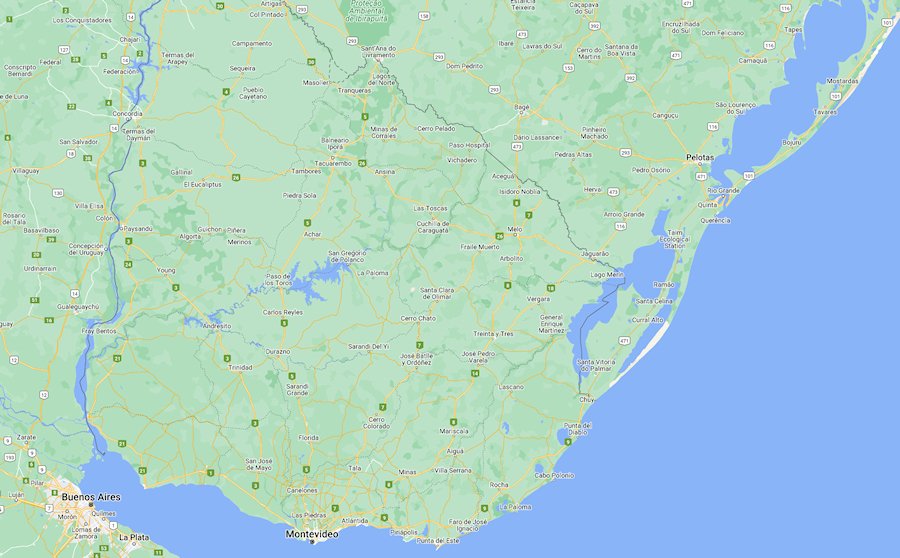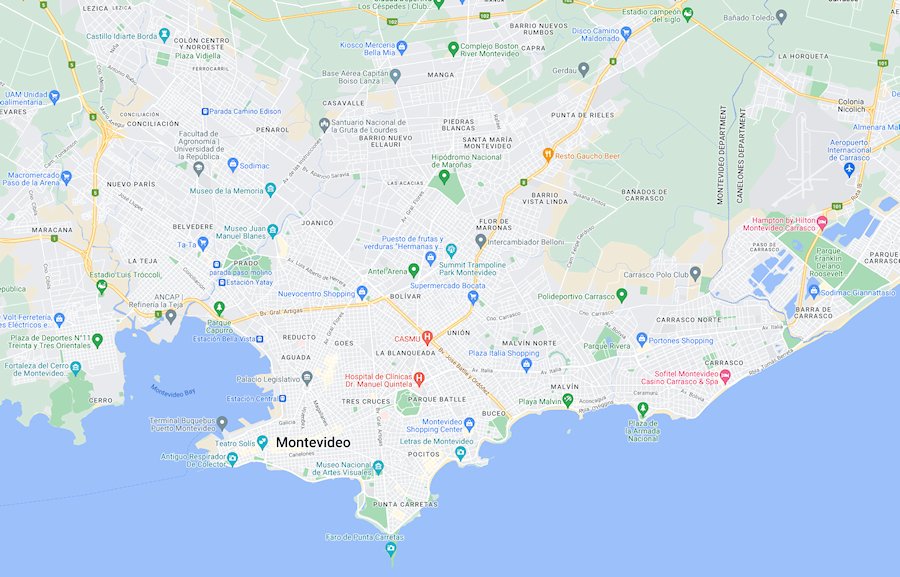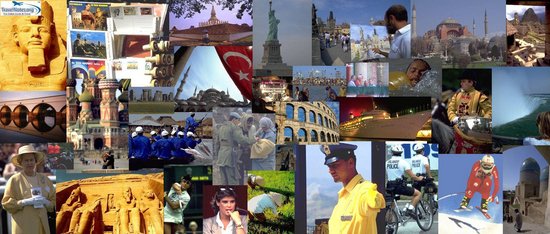Travel Notes: Latin America - Uruguay Travel Notes.
Short URL: https://tnot.es/UY
Uruguay Travel and Tourism on Travel Notes
Visit Uruguay - Explore The Colonial Charm and Natural Wonders
Explore Uruguay's rich history and natural landscapes from UNESCO World Heritage sites, historic and colonial towns, to sandy beaches and verdant forests. Share on Facebook
About Uruguay
Uruguay's rich cultural heritage, diverse landscapes, and warm hospitality make it a fascinating destination worth exploring.
Visit Montevideo, Punta del Este, and Colonia del Sacramento, among others.
Countries neighbouring Uruguay: Brazil and Argentina.
 Add a Business -
Add a Location -
Add a Lodging - Add Travel Content
- Add URL
- Travel Services.
Add a Business -
Add a Location -
Add a Lodging - Add Travel Content
- Add URL
- Travel Services.
Mapping Uruguay
Map of Uruguay
Located in the Rio Plata region, Uruguay is the second smallest country in South America, after Suriname.
It has a diverse landscape featuring rolling plains, low hills, and some coastal areas.
The capital city of Uruguay is Montevideo; a vibrant cultural and economic hub situated on the country's southern coast.
Uruguay Overview
Uruguay, officially known as the Oriental Republic of Uruguay, is a country located in the south-eastern region of South America; bordered by Argentina to the west, Brazil to the north, and the Atlantic Ocean to the south-east.
Uruguay is known for its stability, social progressiveness, and high quality of life, making it a desirable destination for tourists and residents alike.
Culture
Uruguay has a rich cultural heritage influenced by its European, African, and indigenous roots.
The country is known for its literary tradition, with prominent writers such as Juan Carlos Onetti and Mario Benedetti.
Tango and Candombe are popular music and dance styles in Uruguay.
Uruguyans are also passionate about football (soccer); having won the World Cup twice - Uruguay 1930 and Brazil 1950.
Economy
Uruguay has a relatively high-income economy with a strong emphasis on agriculture, services, and tourism.
It has a well-developed social security system and ranks high in various human development indicators.
Education and Healthcare
Uruguay has a well-developed public education system and provides free and compulsory education up to the university level.
Healthcare is also provided through a combination of public and private institutions, with a strong emphasis on universal coverage and accessibility.
Government
Uruguay is a democratic republic with a presidential system; where the president serves as both the head of state and the head of government.
The country has a multi-party system and regularly holds free and fair elections.
History
Uruguay was originally inhabited by indigenous peoples such as the Charrúa and Guarani.
It was colonised by the Spanish in the early 16th century and later became part of the Viceroyalty of the Río de la Plata.
Uruguay gained independence from Spain in the early 19th century and has since experienced periods of political instability, military rule, and democratic governance.
Language
Spanish is the official language of Uruguay.
Population
The majority of the population in Uruguay is of European descent, mainly Spanish and Italian, but there are also significant populations of people with African and indigenous heritage.
Visiting Uruguay
Uruguay offers visitors the chance to explore its rich cultural heritage, stunning landscapes, and vibrant capital city.
Whether you're soaking up the sun on the beaches of Punta del Este or immersing yourself in the history of Colonia del Sacramento, you're sure to create unforgettable memories in this charming country.
Colonia del Sacramento
Barrio Histórico
Step back in time as you explore the cobbled streets and colonial architecture of Colonia del Sacramento's Barrio Histórico.
This UNESCO World Heritage Site is filled with quaint cafes, art shops, and museums.
Faro de Colonia
Climb the lighthouse for panoramic views of the city and the Rio de la Plata.
Rio de la Plata
Take a boat tour on the Rio de la Plata, offering scenic views of the coast and opportunities for fishing and water sports.
Local Cuisine
Asado
Indulge in a traditional Uruguayan barbecue, featuring succulent cuts of meat grilled to perfection.
Chivito
Try the chivito, Uruguay's national dish, which consists of a hearty sandwich filled with steak, ham, cheese, lettuce, tomato, and mayonnaise.
Mate
Experience the ritual of drinking mate, a traditional herbal tea shared among friends and family.
Montevideo
Cabildo de Montevideo
Explore this historic building that served as the seat of colonial government in the 18th century.
Mercado del Puerto
Dive into the culinary scene at Mercado del Puerto, a lively market offering traditional Uruguayan cuisine, including mouthwatering asado (barbecue).
Old City (Ciudad Vieja)
Wander through the cobblestone streets of the Ciudad Vieja, where colonial buildings stand alongside modern cafes and art galleries.
Plaza Independencia
Start your exploration in Montevideo, Uruguay's capital, with a visit to Plaza Independencia.
This historic square is surrounded by architectural gems like the Solis Theatre and the Palacio Salvo.
Rambla
Take a stroll along the Rambla, a picturesque coastal promenade stretching for miles; perfect for enjoying sunset views over the Rio de la Plata.
Natural Attractions
Parque Nacional Santa Teresa
Discover the natural beauty of Santa Teresa National Park; home to pristine beaches, hiking trails, and diverse wildlife.
Quebrada de los Cuervos
Hike through the stunning landscapes of Quebrada de los Cuervos; a dramatic canyon located in the interior of Uruguay.
Punta del Este
Casapueblo
Visit Casapueblo, a sprawling white-washed complex designed by artist Carlos Páez Vilaró.
It serves as a museum, art gallery, and hotel, offering stunning views of the coastline.
Gorlero Avenue
Shop and dine along Gorlero Avenue, Punta del Este's main thoroughfare, lined with boutiques, cafes, and restaurants.
Playa Brava and Playa Mansa
Explore the beaches of Punta del Este, known for their golden sands and clear waters.
Playa Brava is famous for its iconic sculpture 'La Mano', by Chilean artist Mario Irarrzabal, emerging from the sand.
Wine Regions
Canelones
Visit the wine region of Canelones, known for its vineyards and wine production.
Take a tour of the wineries and indulge in tastings of Uruguay's renowned Tannat wine.
Maldonado
Explore the vineyards and olive groves of Maldonado, another wine-producing region known for its picturesque landscapes.
The Uruguay River - Rio Uruguai
Rising in the coastal range of southern Brazil, between Curitiba and Porto Alegre, the river flows west towards Argentina; forming the boundary between the two nations.
The River Uruguay then runs south, between Argentina and Uruguay and empties into the Rio de la Plata.
Large boats can reach Paysandu and smaller vessels may continue to Salto; 320 km from the river's mouth.
Montevideo
Map of Montevideo
The capital of the Republica Oriental del Uruguay is in the southern part of the country, on the Rio de la Plata; a modern city with the heart of a village and excellent beaches nearby.
Montevideo was founded by the Spanish governor of Buenos Aires, in 1726, to prevent the Portuguese from Brazil extending south and fortifying the strategic heights in the region.
Spanish-Portuguese rivalry continued into the early 19th century, until Montevideo was made the capital of independent Uruguay, in 1828, acting as a buffer state between Spanish Argentina and Portuguese Brazil.
Where to Stay in Uruguay
Punte del Este
Punte del Este is a popular beach resort.
Also visit the nearby islands of Gorniti and Lobos.
Rivera
The northern Uruguayan border town of Rivera shares a through street with the Brazilian city of Santana do Livramento.
This is the northern terminus of the Uruguayan railway system and a good place to Enter Brazil.
Uruguay Tourism
Uruguay is enjoyable all year round; a country overflowing with culture and nature marked by traditions, native flavours and the warmth of its people.
The US Embassy in Uruguay is located at Lauro Müller 1776, in Montevideo.
Uruguayan Embassies
Embassy of Uruguay in the United States:
2715 M st. N.W, 3rd Floor, Washington D.C..
Uruguay Travel Guides
Uruguay Travel Guides - Uruguay Maps.
Weather in South America:
Local weather forecasts for destinations around Latin America.
|
|
More From Travel Notes
Travel Notes Online Guide to Travel
Africa - Asia - Caribbean - Europe - Middle East - North America - Oceania - South America.
The Travel Notes Online Guide to Travel helps visitors plan their trip with country and city travel guides, local tourist information, reviewed web sites, and inspiring travel content.
Travel and Tourism Guides on Travel Notes
 If you find Travel Notes useful, please take a moment to
like us on Facebook and share with your friends on social media.
If you find Travel Notes useful, please take a moment to
like us on Facebook and share with your friends on social media.
Share on Facebook
Travel Resources
.
Travel & Tourism With Industry Professionals.














